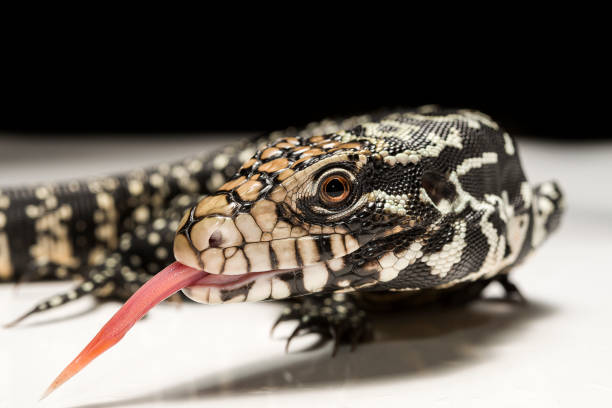Basic Care: Tegus
Tegus are intelligent and curious lizards that can be tamed and trained with regular handling and interaction.The Salvator species are the most commonly kept Tegus in captivity and include the Argentine black and white tegu (Salvator merianae) and the Red tegu (Salvator refescens). Both these species are larger then the Colombian or Tupinambis tegus of which the most common Tupinambis species is the Colombian black and white tegu (Tupinambis teguixin). These lizards are characterized by their large size, muscular limbs, and spotted pattern and most are omnivores, meaning they eat both plants and animals. Tegus are very active opportunistic hunters, hunting their own prey as well as scavenging carrion where it is available. Tegus are extremely intelligent; in fact, some argue that tegus are the most intelligent species of lizard.
(Salvator merianae) and the Red tegu (Salvator refescens). Both these species are larger then the Colombian or Tupinambis tegus of which the most common Tupinambis species is the Colombian black and white tegu (Tupinambis teguixin). These lizards are characterized by their large size, muscular limbs, and spotted pattern and most are omnivores, meaning they eat both plants and animals. Tegus are very active opportunistic hunters, hunting their own prey as well as scavenging carrion where it is available. Tegus are extremely intelligent; in fact, some argue that tegus are the most intelligent species of lizard.
Depending on the species, tegus grow to be between 24”-60” (61-152 cm) long, weighing 8-15 lbs (3.6-6.8 kg). They are considered “large” lizards, and have special care considerations owing to that size. The tip of their tongue is forked to help them “smell” their environment better. By flicking their tongue, they acquire sensory information from the environment, and when the tongue is replaced into the mouth, a gland at the roof of the mouth, the vomeronasal gland, or Jacobson’s organ, helps process this information.
Tegus are sexually mature at 3 years old and go on to have an average lifespan of 15-20 years. In young individuals gender determination can be difficult. However, males have a single scale on the underside of their tail base on both sides of their cloacal vent, this is missing in females. As a male tegu matures these spots can be felt as small raised bumps. Males will also tend to have more well developed jowls.
Enclosure/ Substrate
In the wild, tegus are mostly ground dwelling burrowing lizards and due to their large size means they need a large enclsoure that allows for digging and climbing. A minimum 6-feet-long, 3-feet-deep, and 3 feet tall (180cm x 90cm x 90cm) is required. Given the appropriate substrate they will often spend most of their time buried. It is recommended to have newspaper, butcher paper or tarp as a base, with a large section of deep (2 feet (60cm)) topsoil or aspen bedding for encouragement of natural burrowing behavior. The papered area provides an area to safely feed your tegu while avoiding substrate ingestion and provides an easier way to clean the naturalistic substrate.
Lighting/ Heating
Tegus require 12-14 hours of daily exposure UVB for their health. In captivity, this should be supplemented by opportunities to bask in real sunlight as often as weather permits. Temperature in the enclosures should range from 75° Fahrenheit (24° Celsius) on the cool side to 85-95° Fahrenheit (29-35° Celsius) on the warm side. There also needs to be a basking area where the temperature reaches 95-100° Farhrenheit (35-38° Celsius). Temperatures should be monitored using either an infrared laser thermometer or standard thermometers. Due to the regions that tegus originate, humidity requirements are high and should be maintained around 80%. Hygrometers should be used to monitor the humidity.
In Argentina, it is hot in the summer and cold in the winter and Tegus in the wild will brumate (hibernate) in the winter months. You can let your pets have a period of brumation if you or they prefer. A lot of tegus kept in northern climates will choose to do so starting around mid September, unless you increase your wintertime heating in the enclosure.
Diet
Tegus are omnivores, meaning they can eat both plant and animal tissues. Young tegus will be primarily insectivores and should be fed every day. Gradually they will move up to larger prey items. Offer a variety of insects, such as dubia roaches, crickets, phoenix worms, etc. Adults can be fed frozen thawed rodents, eggs, lean ground meats (specifically ground turkey), fish and a variety of vegetables and smaller amounts of fruits. Another option for feeding adults would be Repashy superfoods gel food premixes Chicken Pot Pie. Tegus 1-3 years old should be fed every other day, once they are over 3 years of age can be fed every 3 days.
Calcium supplement without D3 is recommended and should be sprinkled onto or mixed into the food with every meal. A multivitamin is recommended to be mixed into the food once weekly. Supplementation recommendations do not vary with the age of your animal.



